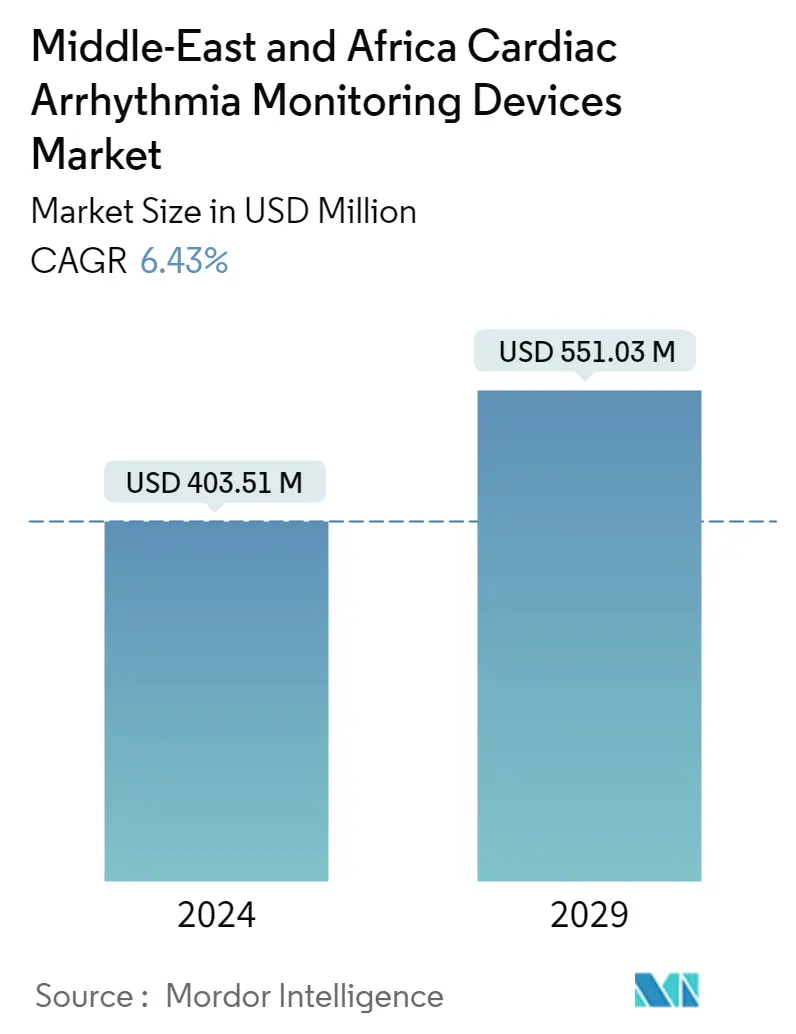Market Size of Middle-East & Africa Cardiac Arrhythmia Monitoring Devices Industry

| Study Period | 2019 - 2029 |
| Base Year For Estimation | 2023 |
| Forecast Data Period | 2024 - 2029 |
| Market Size (2024) | USD 403.51 Million |
| Market Size (2029) | USD 551.03 Million |
| CAGR (2024 - 2029) | 6.43 % |
| Market Concentration | Medium |
Major Players
*Disclaimer: Major Players sorted in no particular order |
Middle-East & Africa Cardiac Arrhythmia Monitoring Devices Market Analysis
The Middle-East & Africa Cardiac Arrhythmia Monitoring Devices Market size is estimated at USD 403.51 million in 2024, and is expected to reach USD 551.03 million by 2029, growing at a CAGR of 6.43% during the forecast period (2024-2029).
- The COVID-19 pandemic placed enormous pressure on hospitals and healthcare systems that were understaffed and overworked. For instance, according to the study published by MDPI, in January 2023, several serious and potentially fatal adverse events and complications have been documented in association with COVID-19 vaccinations, including cardiac arrhythmias in Saudi Arabia. Therefore, increased serious and potential cardiac events due to COVID-19 impacted the demand for cardiac arrhythmia monitors. Currently, as the market is gradually stabilizing due to the decline in COVID-19 cases resulting in the return of the normal demand levels for therapeutic and diagnostic procedures, the market is expected to gain its growth pace over the coming 2-3 years.
- Factors driving the market growth include the increasing prevalence of cardiovascular diseases and risk factors, technological advancements, and the growing adoption of cardiac arrhythmia monitoring devices. For instance, the study published by the National Institutes of Health in August 2021 concluded that the incidence of stroke in Saudi Arabia is 43.8 per 100,000. Personal history of hypertension was chosen as a risk factor by the majority of the participants (81.7%), followed by a personal history of stroke (74.1%) and personal history of dyslipidemia (57.2%).
- The study further stated that there was a low level of awareness regarding cardiovascular diseases and their risk factors, which resulted in a higher prevalence of the disease. Furthermore, according to a study published in the Cardiovascular Journal of Africa in May 2021, every hour, five people have suffered from a stroke, and ten people suffered a heart attack. Therefore, such a growing burden of cardiovascular diseases is expected to boost the market's growth over the analysis period.
- Additionally, various strategies adopted by the key market players, such as promotion, product launches, mergers, and acquisitions to enhance their product portfolio and growth, are anticipated to drive the market over the forecast period. For instance, in January 2023, UltraLinQ launched Holter Service, enabled by LifeSignals, a complete Wireless Holter Monitoring ECG Analysis and Reporting System, offering wireless ECG recording with clinical-grade wearable biosensors at Arab Health Exhibition and Congress.
- Thus the factors mentioned above are expected to drive the market's growth over the forecast period. However, the lack of proper reimbursement impeded the market's growth.
Middle-East & Africa Cardiac Arrhythmia Monitoring Devices Industry Segmentation
As per the scope of the report, cardiac arrhythmia monitoring devices are used for monitoring patients at risk or with heart arrhythmia. These devices detect and alarm irregular heartbeats that are either too slow or too fast.
The Middle East and Africa cardiac arrhythmia monitoring devices market is segmented by devices (event monitoring devices, continuous rhythm monitoring devices, Holter monitoring devices, and other devices), service providers (mobile cardiac telemetry monitoring service providers and independent diagnostic testing facilities/clinics), and geography (GCC, South Africa, Rest of the Middle East and Africa).
The report offers the value (in USD) for the above segments.
| By Device | |
| By Service Providers | |
| Geography | |
Middle-East & Africa Cardiac Arrhythmia Monitoring Devices Market Size Summary
The Middle-East & Africa cardiac arrhythmia monitoring devices market is poised for significant growth, driven by an increasing prevalence of cardiovascular diseases and technological advancements in monitoring devices. The market is gradually stabilizing after the disruptions caused by the COVID-19 pandemic, which had initially impacted demand levels. The rising incidence of cardiac events, such as those linked to COVID-19 vaccinations, has heightened the need for effective monitoring solutions. Factors such as obesity, old age, and other risk factors are contributing to the demand for continuous rhythm monitoring devices, which offer real-time heartbeat tracking and analysis. The market is further bolstered by strategic initiatives from key players, including product launches and collaborations, aimed at enhancing product offerings and expanding market reach.
In the Gulf Cooperation Council (GCC) region, the demand for cardiac arrhythmia monitoring devices is expected to grow due to the high prevalence of heart diseases and associated risk factors. Countries like the UAE and Saudi Arabia are investing heavily in healthcare infrastructure, which is anticipated to positively impact the market. Awareness campaigns and strategic partnerships are also playing a crucial role in driving market growth by promoting early detection and management of cardiac arrhythmias. The competitive landscape is characterized by the presence of major companies such as Nihon Kohden, BioTelemetry Inc., GE Healthcare, Abbott, Philips, and Medtronic, which are actively involved in expanding their product portfolios and enhancing market presence.
Middle-East & Africa Cardiac Arrhythmia Monitoring Devices Market Size - Table of Contents
-
1. MARKET DYNAMICS
-
2. MARKET SEGMENTATION (Market Size by Value - USD)
Middle-East & Africa Cardiac Arrhythmia Monitoring Devices Market Size FAQs
How big is the Middle-East & Africa Cardiac Arrhythmia Monitoring Devices Market?
The Middle-East & Africa Cardiac Arrhythmia Monitoring Devices Market size is expected to reach USD 403.51 million in 2024 and grow at a CAGR of 6.43% to reach USD 551.03 million by 2029.
What is the current Middle-East & Africa Cardiac Arrhythmia Monitoring Devices Market size?
In 2024, the Middle-East & Africa Cardiac Arrhythmia Monitoring Devices Market size is expected to reach USD 403.51 million.

